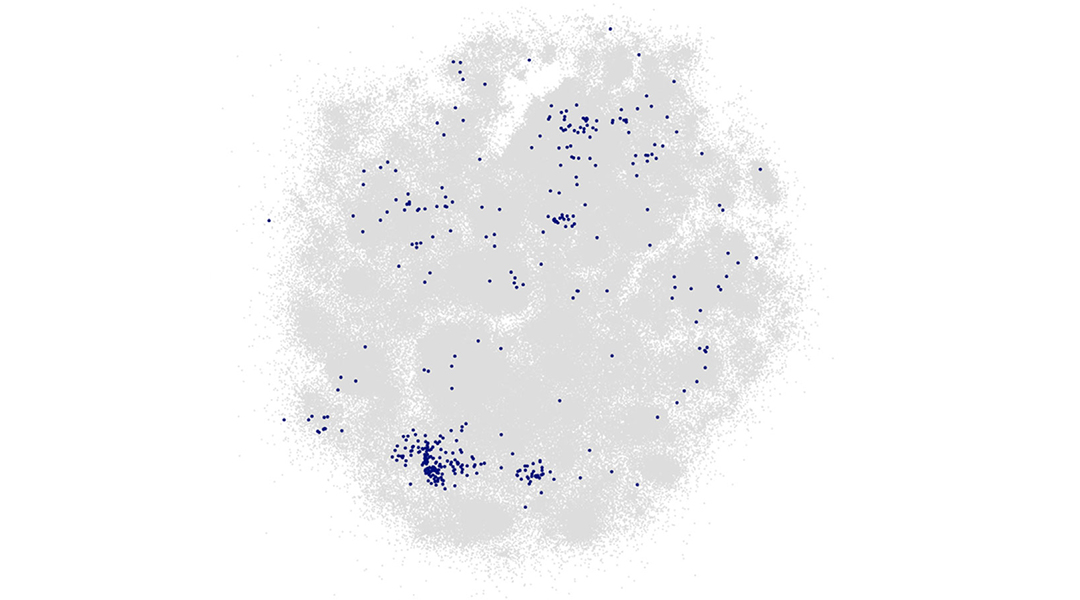UMAP plot of DFT calculated bandgaps
As technology advances, finding the perfect material to make a phone screen brighter, a solar cell lighter, or let an electric car travel further is trickier than finding a needle in a haystack.
It has been estimated that there are more potentially undiscovered materials than there are atoms in the universe! Though this is promising when it comes to advancing technology, finding the right material for a specific application becomes rather difficult. For example, one of the biggest problems in designing solar cells is that the properties of the materials used to construct them don’t match all the energies of the light in the solar spectrum. This means that a portion of incident light gets wasted, spurring the search for another material that can harvest it all.
Clicking the thinnest materials together
In a recent study published in the journal Advanced Intelligent Systems, an international team of researchers has used machine learning to find these ideal materials.
The team focused on 2D materials — materials as thin as a single atomic layer — to hone their machine learning approach. These materials can either conduct electricity better than copper, be a near perfect insulator, or anything in between, making them ideal for a wide range of current or future electronic and optical device applications.
There are currently around 2000 known 2D materials. What makes them particularly interesting is when they are stacked in layers, one on top of each other like Lego blocks, the new material that is now a composition of different material layers has properties that are completely different to that of its base components—like stacking a yellow and blue Lego blocks together and the stacked turn bright green or orange or red.
This means that while you may have access to millions of potential, new materials and properties, figuring out the right combination, predicting what those properties will be, or finding the best one for any application is nearly impossible using conventional experimental methods.
Finding the needle
Enter the multidisciplinary team of chemical engineers, materials scientists, physicists, and most importantly, computational chemists. To solve this problem of a needle in a haystack, the team fed known properties of 2D materials into a new type of machine learning algorithm called “Active Learning”, which seeks out gaps in the data and focuses its predictions there.
This as a computer program that learns relationships between 2D structures and useful electronic or optical properties in a similar way to humans: by being shown examples. For example, people outside of Australia learnt from a young age that all swans were white but revised their ideas when they saw Australian swans were black. In a similar way, active learning speeds up machine learning by identifying where models are bad at predicting properties and adding these examples to the data to train the new model. This improves predictions without having to physically make and test an impossible number of new materials.
This has let the team predict the optical and electronic properties of over 2.2 million combinations of different 2D materials. The accuracy of predictions was checked by keeping some 2D materials separate from the model, then predicting their properties using the model generated from the rest of the data.
The team has made these predictions of electronic and optical properties freely available for the research community to study – paving the way for others to build and test these 2D material combinations.
Since there is such a massive number of materials – with such amazingly diverse properties – the team has gone a step further and broken these down into combinations that absorb specific colours of light. In the future, simply by selecting the correct combination of “Lego block” 2D materials, engineers will be able to match the energy gaps in the material to the solar spectrum to give the maximum efficiency possible. Additionally, the colour of any surface could be tuned with a coating of only a few atoms, with endless possibilities for solar energy conversion.
Active learning, and machine learning in general, is becoming very important for discovery of “next generation” materials with properties that have not been accessible previously. This study shows how incredibly large numbers of potential materials can have their properties predicted, while minimizing the number of time-consuming and expensive experiments that need to be done. This method will be unvaluable in materials science for rapidly identify materials with the best possible properties for a given task, saving time and resources.
Reference: Marco Fronzi, et al., Active learning in Bayesian neural networks for the bandgap predictions of novel Van der Waals heterostructures, Advanced Intelligent Systems (2021). DOI: 10.1002/aisy.202100080

















